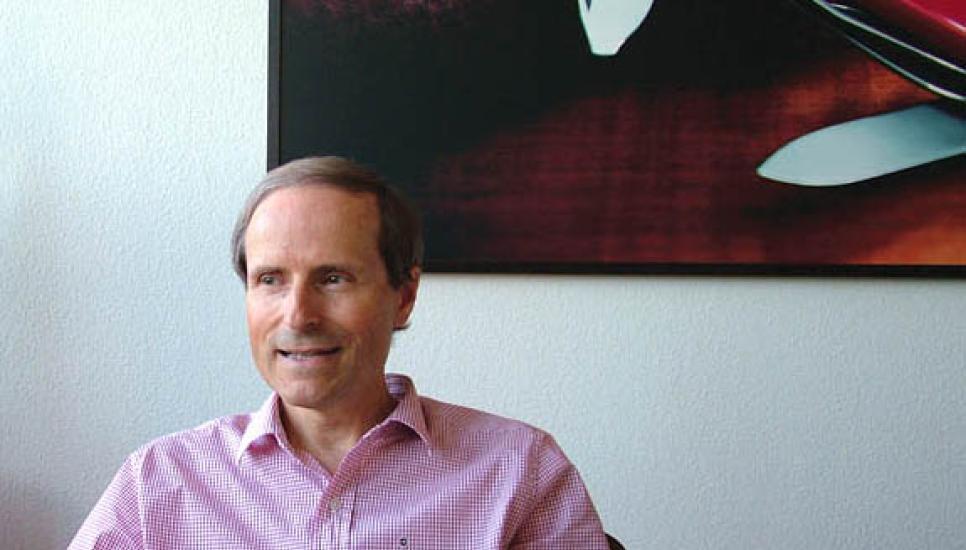A cut above

Ibach, around 60 kilometres south of Zurich, could be described as a typical Swiss Alpine town – ordered streets, suburban shops, affluent population, overlooked by impressive Mont Blanc-style mountains. It’s also home to one of the world’s most iconic brands, the Swiss army knife.
Victorinox, the company that makes the famous pocket knife, has its factory in Ibach; in fact it has been making knives in the town for more than 125 years, most of those in the same factory. Continuity, in terms of connections with the community and manufacture of a group of products all bearing the famous Swiss cross, is very much at the heart of the Victorinox ethos. And that is largely down to the efforts of the managers behind the company for four generations, the Elsener family.
Carl Elsener Jr is the man who currently runs Victorinox. The 52-year-old took over from his father, Carl Elsener Sr, in the early part of the last decade. Carl or Karl is a popular first name in the Elsener clan – three of the four bosses of the company since its inception have been called by that name.
The current chief executive and chairman is proud to say that he oversees a business with sales of more than SFr500 million (€412 million), but he’s not one of those CEOs who rattles off a series of figures about how well the company’s finances are doing. No, Carl would prefer to talk about some of the more interesting milestones in the company’s history, including the Swiss army knife’s voyages into space. “NASA commissioned a special edition for their astronauts,” says Carl.
He adds that the knife has been invaluable in various space mission emergencies, including the first time the space shuttle Atlantis docked with the Russian space station, and one of the tools on the pocket knife was used to open the hatch connecting the two. There are pictures of the moment the penknife was used to open the hatch.
Swiss army knives in space is just one of the many extraordinary episodes in the history of Victorinox. These include bespoke penknives being made for heads of state, including US presidents, and models of the original Swiss army knife being placed in the collections of The Museum of Modern Art in New York and the State Museum of Applied Arts and Design in Munich.
Carl has an infectious personality, and dressed in Victorinox shirt and trousers – the company has a fashion division – he has the athleticism of a man half his age as he practically sprints through the factory, talking rapidly, explaining the various processes of making the pocket knife. Some of them, as with many great brands, are secret.
“We make more than 60,000 pocket knives a day, as well as 60,000 domestic knives,” he says. That makes Victorinox the biggest knife manufacturer in Europe. The Ibach factory has 900 employees, many of them doing seemingly unskilled, or semi-skilled jobs in putting together a pocket knife. This may strike an outside observer as a little strange for a factory in one of Europe’s wealthiest countries, where per capita income, according to the World Bank, is more than $45,000 per annum, the seventh highest in the world. Why is Victorinox employing unskilled labour in one of the most expensive labour markets in the world?
To be fair, Victorinox has invested heavily in high tech machinery to take much of the strain and improve efficiency. But Victorinox has two reasons for keeping a labour-intensive aspect to its production line in the middle of Switzerland. One is easily understood. It means that all products made in the factory can have the “made in Switzerland” mark on them – increasingly, consumers are willing to pay a premium for goods made in Western European countries due to the perceived craftsman-like quality attached to the product, a fact not lost on many family businesses throughout the continent. The second reason is more abstract, and helps to understand the culture of the company.
It seems hard to believe now, given the prosperity of Switzerland, but when Karl Elsener founded the company in 1884 the canton of Schwyz was suffering a deep recession and many workers were leaving for work elsewhere. This was part of Karl’s motivation in setting up the company – to stem the tide of emigration and employ local workers. The efforts paid off and helped to instill a strong tie between Victorinox and the local community as well as effectively create an unofficial “contract” between the company and its employees.
Carl says that nearly all 900 employees across all job disciplines work within a 30-minute commute from the factory. “We are the biggest private sector employer in Schwyz,” he says. Pay is determined by a collective bargaining arrangement and is reviewed annually. Employees seem to like working at Victorinox – it has one of the highest staff retention levels for Swiss companies.
That said, good employee relations and high staff retention rates are found across a host of businesses throughout the Alpine nation – although to be admired, it’s not unique. But Victorinox takes corporate governance to a level virtually unique in today’s corporate world.
Back in 2000 the 100% family-owned business was reconstituted into a foundation, whereby 85% of the share capital in Victorinox was handed over to a foundation, owned and run by the company. Under the rules of the foundation, no family member owns any of the shares in the company and as such cannot sell shares in the business. Carl sits on the board of the foundation.
Asked if this structure means that Victorinox is no longer a family business, its chief executive is in no doubt. “We are still a family business. The family controls the strategy, runs the company and is fully responsible for the company.” The remaining 15% of the business is owned by the Carl and Elise Elsener-Gut Foundation, which is run as a charity.
Carl says the foundation was partly set up by his father to avoid problems with succession and to ensure no family member can sell shares in the company, which might disrupt the ongoing running of the business. “Having 11 children, my father felt there could be issues over ownership in the years ahead,” says Carl. “The foundation avoids any confusion over ownership and is designed to ensure longevity of the company.”
Not only is the Elsener family unable to sell shares in the business, but 90% of annual profits are reinvested back in the business and the remaining 10% are channeled into the Carl and Elise Elsener- Gut Foundation. “All of us are paid a salary and get no dividends,” says Carl.
Is this the very acceptable face of capitalism in the 21st century? The altruism of the family would appear to be something like a religious conviction, and indeed, that is partly the case. The Elsener family are practicing Catholics (Schwyz has the biggest Catholic population of the Swiss cantons) and Carl says he takes his beliefs into the workplace, which helps to understand the thinking behind the foundation.
Certainly, Victorinox represents something almost unique in an age when the corporations that grab the headlines appear to have been around for not much more than ten years and have been valued at tens of billions of dollars. Facebook, Groupon, LinkedIn and Glencore are the obvious examples.
Carl won’t be drawn on whether his model of corporate success can be considered the way forward for capitalism in the 21st century. “It works for us and ensures everyone who is a stakeholder is justly rewarded and treated,” he says.
There is no doubt the Victorinox corporate structure is a virtuous one, and one that is designed to perpetuate the values dear to the heart of the Elsener family. But not all analysts agree that it such a good model for other businesses to adopt.
Joachim Schwass, a professor at Swiss business school IMD, agrees that the company is very successful and that the foundation model has played a part – it has helped Victorinox to diversify effectively and helped it to show terrific resilience, he thinks.
But Schwass is less certain that the foundation strategy encourages entrepreneurship within a family business. “I’m hesitant on these types of structures,” he says. “Each generation should make their own mark on the company and have the chance of being entrepreneurial. Ownership by a foundation can deter this from happening, because foundations serve the purpose of the current generation and trustees.”
But Carl doesn’t appear too phased with business school thinking on corporate structures and governance. “Entrepreneurship can continue to be guaranteed under our structure for future generations,” he says. Carl’s forthright views on corporate structures also come across on how to finance growth. He has little time for banks.
“My father gave me a copy of Henry Ford’s autobiography [My Life and Work] to read, saying it would help me understand the issues and problems encountered when running a business,” says Carl.
“He had underlined important bits in the book, with the heaviest underlined sentences reserved for sections about banks. And the one that stood out the most was a bit about how banks are more than willing to lend when times are good, but much less likely to help in tougher times. They shouldn’t always be trusted,” adds Carl.
No wonder then that bank finance has always been eschewed by Victorinox, which has preferred to rely on a cash reserve built up during good times to help the company through less good periods.
And the company has certainly experienced some hard times – no more so than after the 9/11 terrorists attack in America, when the huge crackdown on airport security led to a ban on selling Swiss army knives in duty free shops. “Sales fell 30%,” says Carl.
Given the company’s strong bond with its workforce, no staff were laid off as a result of the post 9/11 downturn. Instead, the company stopped hiring and reduced shifts.
Employees were encouraged to take holidays early and senior managers approached other companies in the canton to ask if they needed highly qualified workers temporarily. “This helped to build greater loyalty of our staff,” says Carl, “and meant that we could quickly adjust when the upturn began.” Many companies across the world, whether or not inspired by the lessons from Victorinox, adopted similar methods during the economic crisis in 2008/2009, which kept unemployment levels lower in the UK, Germany and the US than in many previous downturns.
The company’s foundation structure means that it has a sizeable cash reserve – although how much Carl won’t reveal – to help it through difficult periods. Revenues grew around 10% in 2010, after two previous years of slow sales as the global downturn affected most manufacturing companies. Ninety percent of all sales are generated from abroad.
Since 9/11, Victorinox has also moved to accelerate its diversification efforts. The company gets around 45% of its sales from non-knife product lines, including 25% from its watch division and 10% each from luggage and fragrance sales.
Diversification has also meant opening retail outlets in a number of cities around the world, with brand stores in Tokyo, New York, Paris, London and Geneva. Carl reckons that controlling the retail outlet experience for customers enables Victorinox to develop the brand as a premium one, with the “made in Switzerland” stamp central to that idea.
Carl is still young and he evidently has considerable energy and vision. Along with his team he is likely to come up with many more ideas of how to take the company forward. But what about the question of succession? “Obviously we would like to see another family member leading the business,” Carl says. Given the family’s strong historical bond with the workforce and the wider community, surely few would be unhappy to see a fifth generation of Elseners at the helm in the years ahead.






